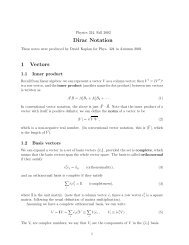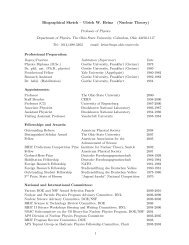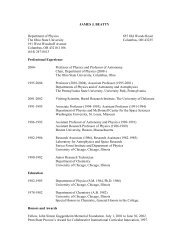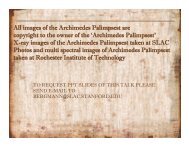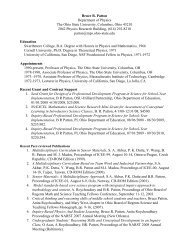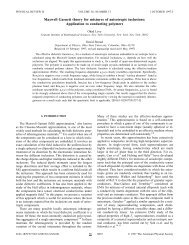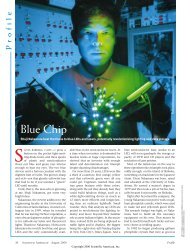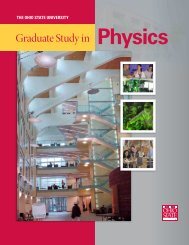From the History of Geradstetten
From the History of Geradstetten
From the History of Geradstetten
You also want an ePaper? Increase the reach of your titles
YUMPU automatically turns print PDFs into web optimized ePapers that Google loves.
<strong>From</strong> <strong>the</strong> <strong>History</strong> <strong>of</strong> <strong>Geradstetten</strong><br />
by<br />
Oberlehrer Julius Seibold<br />
First published on <strong>the</strong> occasion <strong>of</strong> <strong>the</strong> festival:<br />
“Hometown Days, <strong>Geradstetten</strong>, 1960”<br />
Translated by William and Frauke Palmer
Translators’ Preface to “Aus der Geschichte des Dorfes <strong>Geradstetten</strong>” [<strong>From</strong><br />
<strong>the</strong> <strong>History</strong> <strong>of</strong> <strong>Geradstetten</strong>] by Oberlehrer Julius Seibold from <strong>the</strong> booklet<br />
“Heimattage <strong>Geradstetten</strong> 1960" [Hometown Days <strong>Geradstetten</strong> 1960]<br />
On <strong>the</strong> occasion <strong>of</strong> a four-day festival, Hometown Days 1960, <strong>the</strong> town <strong>of</strong> <strong>Geradstetten</strong><br />
published a handsome 100 page booklet which includes a charming article by its school<br />
Headmaster Julius Seibold. For <strong>the</strong> sake <strong>of</strong> family members, o<strong>the</strong>r descendants <strong>of</strong> immigrants<br />
from <strong>Geradstetten</strong>, and any interested parties, we have translated this article into English. We<br />
have tried as best we can to remain true to <strong>the</strong> original text (and hope that those better versed in<br />
German can give us <strong>the</strong>ir advice for changes and improvements).<br />
First, a short biography <strong>of</strong> Julius Seibold, adopted from “Cantate Domino, a Celebration <strong>of</strong> <strong>the</strong><br />
Centenary <strong>of</strong> <strong>the</strong> Church Choir <strong>of</strong> <strong>the</strong> <strong>Geradstetten</strong> Lu<strong>the</strong>ran Community, 1899-1999,” by Hans<br />
Rilling:<br />
Julius Seibold was born im <strong>Geradstetten</strong> on 21 Dec. 1901. Educated as a teacher in<br />
Michelbach/Bilz, his first job was at a school with eight class levels in Schäftersheim. He was<br />
<strong>the</strong> only teacher! He returned to <strong>Geradstetten</strong> in 1948, and served <strong>the</strong>re as Headmaster <strong>of</strong> <strong>the</strong><br />
local school.<br />
With great industry he applied himself to <strong>the</strong> study <strong>of</strong> local history. Herr Seibold wrote down <strong>the</strong><br />
results <strong>of</strong> his research in many manuscript pages, but unfortunately published little <strong>of</strong> it. What<br />
survives is his <strong>History</strong> <strong>of</strong> <strong>the</strong> Town <strong>of</strong> <strong>Geradstetten</strong> Since <strong>the</strong> Middle Ages [printed in<br />
Heimattagen 1960, and translated here intoEnglish], a history <strong>of</strong> <strong>the</strong> school, and a survey <strong>of</strong> <strong>the</strong><br />
historical houses in <strong>Geradstetten</strong>. With <strong>the</strong> county archivist Rummel, he looked through all <strong>the</strong><br />
civil and church proceedings, and preserved for posterity <strong>the</strong> most interesting documents. He<br />
was extremely active in retirement, working tirelessly on <strong>the</strong>se activities. He died on 20 Dec.<br />
1983 in Schorndorf, and is buried in <strong>Geradstetten</strong>.<br />
He was choir director in <strong>Geradstetten</strong> from 1954 to 1960, succeeded by Hans Rilling. The choir<br />
pr<strong>of</strong>ited from Herr Seibold’s history hobby. No festival was complete without a talk from him on<br />
ii
<strong>the</strong> early town history. He knew how to relate this in a light and lively way for all to enjoy. He<br />
spiced all <strong>the</strong>se talks with anecdotes from his experience as a teacher and choir director. He took<br />
his choir director responsibilities very seriously, carried <strong>the</strong>m out in a scholarly way, and always<br />
joined in with <strong>the</strong> singing with his powerful tenor voice.<br />
Translators' Notes<br />
Translating his history has not been an easy one because Herr Seibold wrote for a knowledgeable<br />
hometown audience, taking for granted familiarity with local geography and word usage.<br />
Concerning geography, it is helpful to know that <strong>the</strong> town lies in <strong>the</strong> valley <strong>of</strong> <strong>the</strong> Rems River,<br />
which runs in westerly direction toward Stuttgart some 15 miles away. Parallel to <strong>the</strong> Rems on<br />
<strong>the</strong> north and south side <strong>the</strong> land slopes steeply upward to ridges about 600 feet above <strong>the</strong> river<br />
bed. Before <strong>the</strong> advent <strong>of</strong> a smattering <strong>of</strong> light industry after <strong>the</strong> 1900s, <strong>the</strong> town itself consisted<br />
<strong>of</strong> closely clustered houses surrounded by a patchwork <strong>of</strong> cultivated fields, meadows, orchards,<br />
vegetable gardens, vineyards and forests reaching high up <strong>the</strong> ridges. Each land feature (creek,<br />
slope, trail, ridge) has a historical name that Herr Seibold uses to indicate your location as he<br />
takes you on his walking tour through <strong>the</strong> history <strong>of</strong> <strong>the</strong> town.<br />
Because <strong>of</strong> all <strong>the</strong>se references, his article is best read with a map <strong>of</strong> <strong>Geradstetten</strong> handy. There<br />
is one on <strong>the</strong> web page, http://www.remshalden.de, but a hard copy is even handier. It is helpful<br />
to know that <strong>the</strong> names <strong>of</strong> <strong>the</strong> land features have suffixes that describe <strong>the</strong> current or historical<br />
land use:<br />
German Suffix English Meaning<br />
--äcker field<br />
--bach creek<br />
--gasse side street<br />
--halde slope<br />
--h<strong>of</strong> courtyard, farm, homestead (Geradsetten has several small satellite towns,<br />
which Herr Seibold calls Weiler [Hamlets] which usually have <strong>the</strong> suffix<br />
h<strong>of</strong>.)<br />
--rain ridge<br />
--steg path, climb<br />
--steig path<br />
--strasse road, street<br />
--weg path or trail<br />
--weide pasture<br />
--wiese meadow<br />
Additionally it is useful to understand <strong>the</strong> metric land measure units; 1 a (Ar) = 100 square<br />
meters. 1 ha (Hektar) = 100 a = 2.47 acres. A Morgan is ano<strong>the</strong>r term for a Hektar.<br />
Germany did not emerge from <strong>the</strong> feudal system until 1600s, with some vestiges remaining for<br />
many more years. Thus one encounters in Herr Seibold’s history some terms <strong>of</strong> <strong>the</strong> times that<br />
we translate as follows. (Where a translators note seemed helpful, we have place it in square<br />
brackets: [Translator’s note].) For titles we use <strong>the</strong> correspondences Herzog [Duke], Graf<br />
iii
[Count], Freiherr [Baron], Ritter [Knight]. Bauer can mean farmer or peasant. Schul<strong>the</strong>iss we<br />
have translated as mayor. Wingerter is a dialect <strong>of</strong> Weingaertner, <strong>the</strong> main traditional occupation<br />
<strong>of</strong> <strong>Geradstetten</strong>, a person who cultivates grapes for wine production, from tending <strong>the</strong> vineyards<br />
to producing <strong>the</strong> wine. For want if a better term we use vineyardman.<br />
Palmer, Lederer, Seibold are among <strong>the</strong> most common names in <strong>Geradstetten</strong>, especially in <strong>the</strong><br />
olden days. If you trace my family line as far back as it goes, to <strong>the</strong> 1500s, <strong>the</strong>ir listed occupation<br />
is inevitably Wingerter though several were also Schul<strong>the</strong>iss [Mayor] on <strong>the</strong> side. Those <strong>of</strong> us<br />
who wish to find noble blood in our lines will perhaps be disappointed. Among <strong>the</strong> string <strong>of</strong><br />
major and minor nobility that are mentioned in this history, <strong>the</strong>re no Palmers, Lederers, or<br />
Seibolds. Bauers, yes. Wingerters, yes. Schul<strong>the</strong>iss, yes. Graf, Herzog, Freiherr, Ritter,<br />
definitely no.<br />
It is helpful to understand, as you read this history, that <strong>the</strong> <strong>Geradstetten</strong> agricultural economy<br />
(for many centuries its only economy) was long dominated by <strong>the</strong> wine production from <strong>the</strong><br />
vineyards on <strong>the</strong> south-facing slopes. At <strong>the</strong> same time, milk cows and stock for meat and draft<br />
were maintained, and swine and poultry were also raised. Orchards and gardens produced o<strong>the</strong>r<br />
table fare. Originally <strong>the</strong>re was much land in pasture, but in 1800 <strong>the</strong> switch was made to feed<br />
<strong>the</strong> animals from hay and grain.<br />
At <strong>the</strong> beginning <strong>of</strong> Herr Seibold’s article we have placed a Chronology which in <strong>the</strong> original<br />
booklet appears (unsigned) after <strong>the</strong> article, but seems based on its contents, with some o<strong>the</strong>r<br />
materials <strong>of</strong> a 1950s flavor tacked on to its end. These last display <strong>the</strong> spirit <strong>of</strong> pride and<br />
optimism that <strong>the</strong> towns people felt in <strong>the</strong> year 1960, as Germany emerged from a 15-year period<br />
<strong>of</strong> recovery from <strong>the</strong> devastation <strong>of</strong> WW II.<br />
Finally, a personal note about what Herr Seibold has done for one <strong>of</strong> us (wfp). Immigrants live<br />
in two worlds and move mentally between <strong>the</strong>m quite successfully. This is sometimes confusing<br />
for <strong>the</strong>ir children. And so in New York when my parents came toge<strong>the</strong>r with o<strong>the</strong>rs from<br />
<strong>Geradstetten</strong>, <strong>the</strong>y entered easily into that o<strong>the</strong>r world, and talked around <strong>the</strong> table with a glass <strong>of</strong><br />
(California) wine at hand about old times and old places. As a young boy, <strong>the</strong>refore, even as <strong>the</strong><br />
Allied Armies marched across France and bombers made <strong>the</strong>ir runs on Stuttgart, I heard<br />
(endlessly, I thought) about Herbsthalde, Wolfäker, Grabenwiesen, and o<strong>the</strong>r places with<br />
magical names so very far away. In later years I came to see <strong>the</strong>se places, and even walk about<br />
<strong>the</strong>m, but <strong>the</strong>y all were part <strong>of</strong> a blur <strong>of</strong> family visits, a jumbled confusion <strong>of</strong> impressions,<br />
somehow incomplete. Now, with map in hand, and guided by Herr Seibold’s 40-year old words,<br />
I have achieved a kind <strong>of</strong> completion <strong>of</strong> perspective: <strong>the</strong> magic is still <strong>the</strong>re, but <strong>the</strong> blur is gone<br />
as <strong>the</strong> places are explored again, enriched by his historical ramblings. For <strong>the</strong>se I am grateful.<br />
William and Frauke Palmer<br />
January 2001<br />
iv
“Blick in die Chronik von <strong>Geradstetten</strong>” (A Look at a <strong>Geradstetten</strong><br />
Chronology, from <strong>the</strong> booklet Heimattage <strong>Geradstetten</strong> 1960)<br />
1238 First historical mention <strong>of</strong> <strong>the</strong> town’s name “Gerhartstetin” (H<strong>of</strong>staette [Manor] <strong>of</strong><br />
Gerhart). At this time Winterbach was its parent town (Mutterort), but since 1415<br />
<strong>Geradstetten</strong> was an independent community.<br />
1291 In a history <strong>of</strong> Duke Eberhard <strong>of</strong> Wuerttemberg, “Rufo von Gerhartstettin” was noted as<br />
a vineyardman (“der Wingarter” [spelling variant <strong>of</strong> Wingerter]). Thus already in <strong>the</strong>se<br />
times <strong>the</strong> vineyards on <strong>the</strong> south-facing hills <strong>of</strong> <strong>the</strong> town must have played an important<br />
role. This is also verified by a document <strong>of</strong> 1371 in which Melchior von Ebersbach sold<br />
“all <strong>of</strong> my wine presses” to Seifried von Zülnhard.<br />
1374 First mention <strong>of</strong> <strong>Geradstetten</strong>’s small outlying settlement now known as Bauersberg-H<strong>of</strong>,<br />
<strong>the</strong>n called Stullhardtsh<strong>of</strong>.<br />
1497 The Bishop <strong>of</strong> Constance approved <strong>the</strong> establishment <strong>of</strong> a <strong>Geradstetten</strong> parish. Formerly<br />
<strong>Geradstetten</strong> belonged to <strong>the</strong> Winterbach parish [but maintained a chapel in town.] The<br />
oldest chapel in town was said to be built in 1309.<br />
1514 <strong>Geradstetten</strong> was involved in <strong>the</strong> peasant revolt “Armen Konrad” [Poor Konrad]. Ten<br />
men had to flee to escape punishment. At this time <strong>the</strong> town had about 100 households<br />
with an estimated population <strong>of</strong> 500.<br />
1534 Duke Ulrich von Wuerttemberg brings <strong>the</strong> Reformation to <strong>Geradstetten</strong>.<br />
1600 Jakob von Gültingen stabs his friend Konrad von Degenfeld by mistake after a drinking<br />
party in <strong>Geradstetten</strong>. [The event has historical and cultural significance, and is <strong>the</strong><br />
subject <strong>of</strong> a ballade treated in <strong>the</strong> famous folk song collection Das Knabenwunderhorn.<br />
Jakob came from Schorndorf to <strong>Geradstetten</strong> in his capacity as overseer [Vogt] to<br />
transact some business. After a drinking party with his friend Konrad at <strong>the</strong> mayor’s<br />
house, with whom <strong>the</strong>y were staying, <strong>the</strong>y retired. In <strong>the</strong> middle <strong>of</strong> <strong>the</strong> night, a figure<br />
wrapped in a sheet entered Jacob’s room. Frightened, Jacob stabbed <strong>the</strong> man to death. It<br />
turned out to be his friend Konrad. It all appeared to be a mistake, but Jacob, heartbroken<br />
was taken to Waiblingen and thrown into jail, waiting for trial. The townspeople<br />
expected him to be exonerated, but to <strong>the</strong>ir horror he was beheaded. Later it appeared<br />
that <strong>the</strong> Duke who sentenced him was under <strong>the</strong> influence <strong>of</strong> an evil minister, who<br />
himself was beheaded by <strong>the</strong> Duke’s son many years later when his treachery was<br />
exposed.]<br />
1618/48 The Thirty Years’ War wrecks severe damage on <strong>the</strong> town. Over a third <strong>of</strong> <strong>the</strong><br />
buildings are destroyed, and many townspeople are killed or die from epidemics. The<br />
population declines from about 700 to 183 people. The population did not reach 700<br />
again until 1726.<br />
1687 By property transactions with <strong>the</strong> last landlords [outside <strong>of</strong> Württemberg jurisdiction],<br />
v
<strong>Geradstetten</strong> became fully a part <strong>of</strong> Wuerttemberg. In <strong>the</strong> previous centuries families <strong>of</strong><br />
<strong>the</strong> Knights <strong>of</strong> Seldneck, Zülnhard, Lichtenstein, Ebersberg or Ebersbach and Urbach had<br />
property in town outside <strong>the</strong> domain <strong>of</strong> Württemberg.<br />
1760 The so called “Upper Wine Press” and <strong>the</strong> “New Wine Press” (built in 1577) were<br />
dismantled to make room for a new installation.<br />
1786 Pasturing was given up in favor <strong>of</strong> stall-feeding. The number <strong>of</strong> steers multiplied<br />
quickly. In this time <strong>the</strong> “Obstbau” [fruit orchards] also developed very strongly.<br />
1850 The town has 1900 inhabitants. In <strong>the</strong> following famine years <strong>the</strong> town loses about 500<br />
inhabitants, partially to emigration [some to <strong>the</strong> US].<br />
1861 <strong>Geradstetten</strong> gets rail service along <strong>the</strong> newly built Remstal line, but with no station,<br />
using Grunbach’s instead.<br />
1905 The first industry, <strong>the</strong> Robert Kempf textile mill, appears.<br />
1912 The schoolhouse is built on Bahnh<strong>of</strong>strasse.<br />
1917 The second industry arrives, <strong>the</strong> powder mill <strong>of</strong> <strong>the</strong> textile concern Robert Kempf.<br />
1936 Acquisition <strong>of</strong> <strong>the</strong> Robert Kempf factory by <strong>the</strong> Badisch-Württembergische<br />
Wellpapierfabrik [corrugated paper factory] Klingele und Holfelder<br />
1950 Mayor Wilhelm Gayer assumes <strong>of</strong>fice, and is voted in again in 1956. In <strong>the</strong>se years <strong>the</strong><br />
town boomed through planned development <strong>of</strong> industry with its own rail spur and its own<br />
service road along <strong>the</strong> o<strong>the</strong>r side <strong>of</strong> <strong>the</strong> Rems River; construction <strong>of</strong> a settlement for<br />
refugees [German-speaking people fleeing from <strong>the</strong> east after WW II. The population <strong>of</strong><br />
<strong>the</strong> town almost doubled]; and by forward-looking financing <strong>of</strong> sewer appropriations.<br />
1951 50 th year celebration <strong>of</strong> <strong>the</strong> Sport Club <strong>of</strong> <strong>Geradstetten</strong>. Celebration <strong>of</strong> <strong>the</strong> new citizens<br />
[These are <strong>the</strong> refugees referred to above] <strong>of</strong> <strong>the</strong> county <strong>of</strong> Waiblingen. Connection <strong>of</strong> <strong>the</strong><br />
industry park and <strong>the</strong> refugee settlement to <strong>the</strong> new water system.<br />
1953 Celebration <strong>of</strong> <strong>the</strong> first “Heimattage” [The 1960 Heimattage Celebration brought forth<br />
this Chronology in its brochure.] Creation <strong>of</strong> a model layout design for <strong>the</strong> “Obstanlage”<br />
[orchards] on <strong>the</strong> high hills above <strong>the</strong> town.<br />
1953/54 Construction <strong>of</strong> <strong>the</strong> swimming pool with accompanying buildings and playing fields.<br />
Construction <strong>of</strong> <strong>the</strong> new bridge over <strong>the</strong> Rems River to replace <strong>the</strong> old bridge which was<br />
severely damaged in WW II.<br />
1954/56 Construction <strong>of</strong> a new by-pass road for Grossheppach, Grunbach, <strong>Geradstetten</strong>, and<br />
Hebsack.<br />
vi
1956 Major flooding causes wide destruction. Construction <strong>of</strong> a war memorial. Etched in <strong>the</strong><br />
stone are <strong>the</strong> names <strong>of</strong> 61 dead in WW I, and 109 dead and 26 missing in WW II.<br />
1957 For <strong>the</strong> first time <strong>the</strong> town’s annual maintenance budget passed one million DM.<br />
Nothing better illustrates <strong>the</strong> strong boom <strong>of</strong> <strong>the</strong> town than <strong>the</strong> fact that this budget was<br />
185,000 DM in 1949, and had climbed already to 863,000 DM in 1954. Founding <strong>of</strong> <strong>the</strong><br />
Business and Commerce Club. The Music Club “Harmonie” celebrates its 50 th<br />
anniversary.<br />
1958/59 Construction <strong>of</strong> <strong>the</strong> new school and <strong>the</strong> beginning <strong>of</strong> <strong>the</strong> expansion <strong>of</strong> <strong>the</strong> sports<br />
complex. The number <strong>of</strong> employed climbs to 1300. In 1950 it was only 630.<br />
1960 Renovation <strong>of</strong> <strong>the</strong> old school as <strong>the</strong> new Rathaus and breaking ground for construction <strong>of</strong><br />
<strong>the</strong> new Catholic church.<br />
vii
Oberlehrer Julius Seibold: Aus der Geschichte des Dorfes <strong>Geradstetten</strong> [<strong>From</strong><br />
<strong>the</strong> <strong>History</strong> <strong>of</strong> <strong>the</strong> Town <strong>of</strong> <strong>Geradstetten</strong>]<br />
The Stuttgart State Archive contains a purchase record from 1291, in which Count Eberhard der<br />
Rauschebart sold a farm in Schorndorf [town four miles east <strong>of</strong> <strong>Geradstetten</strong>]. Among <strong>the</strong><br />
buyers was a Rufo de Gerhartstetin also known as “Wingerter” [vineyarder]. <strong>From</strong> <strong>the</strong> Swabian<br />
historian Crusius we also know <strong>the</strong> contents <strong>of</strong> a purchase record from1290, among <strong>the</strong> witnesses<br />
to which is named <strong>the</strong> same Rufo. In his history <strong>of</strong> <strong>the</strong> settlement <strong>of</strong> Württemberg, Weller in fact<br />
gives 1238 as <strong>the</strong> oldest record <strong>of</strong> <strong>Geradstetten</strong>, but he does not give his source.<br />
In <strong>the</strong> latter work it is argued that <strong>Geradstetten</strong> was in fact founded in 800 in <strong>the</strong><br />
“karolingischen” times [Times <strong>of</strong> <strong>the</strong> Carolingians, a seventh and eight century dynasty whose<br />
line includes Charlemagne, Karl der Grosse] . This date seems somewhat late because we know<br />
from alemannischen Gräberfunden [old Germanic tribe grave remains] that settlements existed<br />
in Schorndorf and Beutelsbach in pre-Christian times. In a Grunbach [neighboring] town<br />
historical play [Heimatspiel] <strong>the</strong> founding <strong>of</strong> Grunbach is set by G. Seibold using poetic license<br />
as 558.<br />
Concerning <strong>the</strong> question <strong>of</strong> where <strong>the</strong> town center is, that is <strong>the</strong> homestead <strong>of</strong> Gerhart, first note<br />
that new settlements need roads and water, and if <strong>the</strong>y are not <strong>the</strong>re <strong>the</strong>y must be created. Next<br />
one must notice that in early times <strong>the</strong> main traffic moved in <strong>the</strong> east-west direction in this<br />
region. Thus <strong>the</strong> Hochstrasse [High Road] runs on <strong>the</strong> nor<strong>the</strong>rn boundary <strong>of</strong> our town border; it<br />
still serves today as a path from Buoch [neighboring town to <strong>the</strong> north] to Schorndorf, and is<br />
considered a prehistoric and Roman passage. Parallel to this, <strong>the</strong> Hauptstrasse [Main Street] also<br />
goes east-west, through <strong>the</strong> town center, and was probably also used by <strong>the</strong> Romans. The post<br />
route on <strong>the</strong> north side <strong>of</strong> <strong>the</strong> Rems River, a horse and cart road, was ano<strong>the</strong>r road connection,<br />
with a similar road on <strong>the</strong> south side <strong>of</strong> <strong>the</strong> Rems, indicated in <strong>the</strong> 1797 survey [Marktordnung]<br />
<strong>of</strong> Beutelsbach as “Schorndorfer Weg.” This route ran by <strong>the</strong> Fehrenbacher Feldhauslein [small<br />
houses used for shelter in <strong>the</strong> fields] on <strong>the</strong> current Alfred-Klingele Strasse.<br />
The Kaiserstrasse runs only a few meters from our border. It was so named because it carried<br />
deliveries from <strong>the</strong> Hohenstaufen Castle to <strong>the</strong> Kaiserpfalz [palace] in Waiblingen. [The<br />
Hohenstaufen are a dynasty that ruled Germany from 1138 to 1208. They were based in<br />
Swabia.] In <strong>the</strong> Beutelsbacher survery <strong>of</strong> 1797 this road was called “Ulmer Strasse.” For a long<br />
time it served as <strong>the</strong> wine route from Heilbronn to Ulm. We call it a fränkische Heerstrasse,<br />
which ran through Uhlingen to <strong>the</strong> region <strong>of</strong> <strong>the</strong> current autobahn.<br />
Compared to <strong>the</strong>se east-west roads, <strong>the</strong> north-south roads were secondary. They went across <strong>the</strong><br />
Rems River, which in early times impeded traffic, and indeed was frequently flooded. In 1816<br />
<strong>the</strong> Rems was said to have over flowed its banks 15-18 times. River fords were very limited. In<br />
1854 <strong>the</strong>re were 15 fords between Ramsbach by Schorndorf and Zehntenbach by Grunbach. The<br />
important fords for <strong>Geradstetten</strong> were: 1. “Steinfurt” below <strong>the</strong> mouth <strong>of</strong> Grunbach. 2. The ford<br />
by <strong>the</strong> hamlet Fehrenbach, which one can recognize in <strong>the</strong> Gewand Lissin property map <strong>of</strong> 1832.<br />
3. The ford below Lochbach by present day Steg. It was called Wolfsgässlein. 4. The most<br />
important ford was by <strong>the</strong> present day gymnasium and was called Wolfgasse, Viehgasse, or<br />
1
Ziegelhütten ford.<br />
Now more about <strong>the</strong> north-south roads. Below <strong>the</strong> town we have Mühlenweg, so called because<br />
a mill was built <strong>the</strong>re 100 years ago. Earlier it was called Bildstochweg and it originally<br />
connected <strong>the</strong> castle on Kindlesbrunnen with <strong>the</strong> valley roads. The most important north-south<br />
road, however, was <strong>the</strong> Mühlgasse, now [1960] called Bahnh<strong>of</strong>strasse [Rathausstrasse today]. Its<br />
continuation to <strong>the</strong> south is <strong>the</strong> Weinweg which starts from Kaiserstrasse. Its north extension<br />
runs over Staig, an old cart path, to <strong>the</strong> Hochstrasse. Since 1866 it has not been traveled as <strong>the</strong><br />
townspeople that year got permission to use <strong>the</strong> Ru<strong>of</strong>enbergweg.<br />
Now let us talk about water resources. There is <strong>the</strong> Dorfbach [town creek], which today only<br />
school children hear about, that runs under Seegasse and Schmaltzgasse. The creek was diverted<br />
in <strong>the</strong> middle ages around <strong>the</strong> town to <strong>the</strong> Rems ford around where <strong>the</strong> old bridge stood. If you<br />
can reach this marshy area, we conjecture you will find an early stone age settlement. In 1936<br />
Hermann Palmer found a stone plowshare made <strong>of</strong> hornblende slate <strong>the</strong>re.<br />
For every settlement, <strong>the</strong> establishment <strong>of</strong> fountains [Brunnen] was very important. In 1576<br />
<strong>the</strong>re were three fountains. After <strong>the</strong> Thirty Years War, only two remained, a less important one<br />
having been given up. Because <strong>the</strong> Burgbrunnen [Castle Spring] originally served <strong>the</strong> high<br />
stables, <strong>the</strong> town center used only <strong>the</strong> Gaigelerbrunnen which stood across from street from <strong>the</strong><br />
inn “Lamm.” It was given up in 1901. <strong>From</strong> <strong>the</strong> present day construction <strong>of</strong> <strong>the</strong> drainage<br />
system, we know how wet <strong>the</strong> ground is in this region. However, with <strong>the</strong> increased growth <strong>of</strong><br />
<strong>the</strong> town, this water was still insufficient. In 1953 a Middle Ages water line was discovered<br />
made <strong>of</strong> clay pipes that brought additional water from <strong>the</strong> Märzensteige. As far as we know, <strong>the</strong><br />
water from <strong>the</strong> current spring <strong>the</strong>re was led to <strong>the</strong> fountain in wooden chutes.<br />
<strong>From</strong> <strong>the</strong>se considerations <strong>of</strong> water sources and roadways, we can see that <strong>the</strong> original town<br />
center is found somewhere between <strong>the</strong> inns “Krone” and “Lamm.” In <strong>the</strong> oldest property<br />
books <strong>the</strong> current Raitengasse is called “im H<strong>of</strong>.” [in <strong>the</strong> central square or yard] . Whe<strong>the</strong>r <strong>the</strong><br />
name Raitengasse is related by sound to Roite=H<strong>of</strong>raum is not established in our study.<br />
The second root <strong>of</strong> our settlement died away. The Burgstall was last called that in 1495, but <strong>the</strong><br />
term lives on in property descriptions. It lay a few meters south <strong>of</strong> <strong>the</strong> present day children’s<br />
fountain, which is fed by <strong>the</strong> Burgbrunnen [Castle Spring]. By Burgstall is meant <strong>the</strong> castle or<br />
residence <strong>of</strong> a minor nobleman. Apparently <strong>the</strong> family <strong>of</strong> Ruef von Gerhartstetin, to whom we<br />
found a 1290 reference in Schorndorf, resided here. In <strong>the</strong> <strong>of</strong>ficial records, <strong>the</strong> owner <strong>of</strong><br />
Burgstall was given as Herren von Seldeneck. We know however that <strong>the</strong>y [<strong>the</strong> Seldenecks]<br />
held this property for only a short time prior to this. They acquired this property from Ritter von<br />
Ursbach, through marriage, and <strong>the</strong>n gave <strong>the</strong> ownership back to him soon after.<br />
We must say a bit also about <strong>the</strong> o<strong>the</strong>r smaller settlements around <strong>Geradstetten</strong>. Across <strong>the</strong><br />
Rems by <strong>the</strong> railroad station in Alfred Klingele Strasse stood <strong>the</strong> Weiler [Hamlet] Fehrenbach<br />
which in property maps is known as Ferbach and Fehrenbacher Rain. According to various<br />
sources between 1369 and 1416 it was called Verherbach. This changed later to Vehrenbach or<br />
Fehrenbach. In <strong>the</strong> Thirty Years War <strong>the</strong> hamlet disappeared. The hamlet border was<br />
maintained until 1833, but land within it was divided between Grunbach and <strong>Geradstetten</strong>, For<br />
2
this reason I can still find some border markers with <strong>the</strong> letter F. There were two related<br />
hamlets, divided by <strong>the</strong> Postweg into Ober- und Unterfehrenbach [Upper and Lower Fehrnbach.]<br />
The fountain [for <strong>the</strong> hamlet] stood near <strong>the</strong> Rems.<br />
Several hamlets lay high in <strong>the</strong> hills above <strong>Geradstetten</strong>. At <strong>the</strong> forest edge was Bauersberg, also<br />
known as Oberer H<strong>of</strong>. In 1374 it was called Stullhardtsh<strong>of</strong>, in 1525 Mayerh<strong>of</strong>, and later<br />
Schieferlinsh<strong>of</strong>. The names are those <strong>of</strong> <strong>the</strong> earlier owners. The name Bauersberg only emerged<br />
in <strong>the</strong> last century. The original house was taken down in 1800. It stood about where <strong>the</strong> present<br />
Mayerle house is.<br />
At <strong>the</strong> end <strong>of</strong> <strong>the</strong> Thirty Years’ War, Kernersh<strong>of</strong>, ano<strong>the</strong>r hamlet, stood abandoned. The owner<br />
had fled into town for safety. Soon Kernersh<strong>of</strong> found a new settler called Bäder from Grunbach.<br />
The original house is <strong>the</strong> Haus Schäfer, which stood already in 1529, when Hans Vaihingen lived<br />
<strong>the</strong>re. The settlement has <strong>the</strong> fur<strong>the</strong>r name “auf dem Osterberg” because <strong>of</strong> which <strong>the</strong>re is<br />
confusion in <strong>the</strong> old records concerning which settlement is meant. In <strong>the</strong> records after <strong>the</strong><br />
Thirty Years War various names can be found. G. Seibold made <strong>the</strong> connection between<br />
Osterberg and <strong>the</strong> Germanic god Ostara, whose altar could well have stood on <strong>the</strong> heights <strong>of</strong> this<br />
hamlet. Today <strong>the</strong> Osterbach is <strong>the</strong> boundary between Grunbach and <strong>Geradstetten</strong>. We suspect<br />
that Kernersh<strong>of</strong> was founded after <strong>the</strong> boundary was drawn since o<strong>the</strong>rwise it would have been<br />
given to Grunbach.<br />
In contrast to <strong>the</strong>se homesteads that grew into hamlets, Rollh<strong>of</strong> is today still an individual<br />
homestead. In 1588 two farm houses were already mentioned. In 1500 it was called<br />
Zillhardtsh<strong>of</strong> because it was a Zillhardt fief. In 1646/47 <strong>the</strong> remains <strong>of</strong> <strong>the</strong> abandoned<br />
homestead, <strong>the</strong>n called Büchelersberg were sold for salvage. In 1680 it was built up again by <strong>the</strong><br />
son <strong>of</strong> <strong>the</strong> Kernersh<strong>of</strong> farmers. This farm seems to be a more recent settlement, perhaps later<br />
than Bauersberg, because H<strong>of</strong>äcker and Lichterberg are counted among <strong>the</strong> latest. It was a<br />
wonderful setting, but water had to be carried up from <strong>the</strong> Rollbrunnen. Farm stock had to be<br />
driven for water to a small pond that lay behind <strong>the</strong> Segeln over which <strong>the</strong> Eisbronnklinge lay.<br />
<strong>Geradstetten</strong> at <strong>the</strong> End <strong>of</strong> <strong>the</strong> Middle Ages<br />
In general <strong>the</strong> Middle Ages are regarded as <strong>the</strong> period up to 1500. Here I would like to include<br />
<strong>the</strong> Thirty Years War. Originally I wanted to title this section “<strong>Geradstetten</strong> in <strong>the</strong> Age <strong>of</strong><br />
Chivalry [Rittertum].” It appeared, however, that <strong>the</strong> nobility did not give up its privileges until<br />
1687. The last private possessions were not given up until 1800, and <strong>the</strong> duties and obligations<br />
that stemmed from <strong>the</strong> age <strong>of</strong> chivalry were not removed for several more decades.<br />
Since <strong>the</strong> rise <strong>of</strong> <strong>the</strong> Counts <strong>of</strong> Württemberg, <strong>Geradstetten</strong> was partly in <strong>the</strong>ir territorial<br />
possession. It probably was a part <strong>of</strong> <strong>the</strong> inheritance that <strong>the</strong> mo<strong>the</strong>r <strong>of</strong> this family received from<br />
her fa<strong>the</strong>r, <strong>the</strong> last Count <strong>of</strong> Beutelsbach. His castle once stood on <strong>the</strong> Kappelberg, <strong>the</strong> last spur<br />
<strong>of</strong> <strong>the</strong> Schönbühl [a hill] above Beutelsbach. However, only a part <strong>of</strong> our land was in direct<br />
possession <strong>of</strong> <strong>the</strong> Wuerttembergs. The main part was in fief or tenancy to lesser noblemen.<br />
These in turn put <strong>the</strong> land in tenancy to <strong>the</strong> peasants. In later years one can find properties<br />
encompassing as many 20 tenants. The remaining lands that were more loosely held were<br />
encumbered with various assignments and obligations.<br />
3
One cannot in this short treatment completely cover <strong>the</strong> history <strong>of</strong> <strong>the</strong> times and <strong>the</strong> state <strong>of</strong><br />
property divisions. It is sufficient to say a bit about <strong>the</strong> noble families. In 1344 we hear <strong>of</strong><br />
Walter von Ebersberg. His family originally came from Ebersbach an der Fils [ten miles<br />
sou<strong>the</strong>ast <strong>of</strong> <strong>Geradstetten</strong>] and later had <strong>the</strong>ir castle in Burgholz by Unterberken. In 1374<br />
Seifried von Zillhart took over <strong>the</strong>se lands. This noble family was originally from Schlat<br />
(County Göppingen) [15 miles sou<strong>the</strong>ast] but <strong>the</strong>n bought property in Dürnau. In 1356<br />
Schweniger vom Lichtenstein by Honau sold his portion to Württemberg. In 1369 we learn <strong>of</strong><br />
Johann vom Seldenegg, a family from <strong>the</strong> Ro<strong>the</strong>nburg region, related to Herr von Urbach, whose<br />
castle ruled over Oberurbach. [It is clear from this section <strong>the</strong> town was held by a shifting<br />
collection <strong>of</strong> mostly absentee owners, based a day or more ride away by horse.]<br />
Increasingly <strong>the</strong> Württembergers came into possession <strong>of</strong> <strong>the</strong> town. Our oldest sources in <strong>the</strong><br />
town archives are concerned with property transaction <strong>of</strong> 1506/07 between Zillhart and Duke<br />
Ulrich von Württemberg. Henceforth Württemberg possessed two-thirds <strong>of</strong> <strong>the</strong> town and<br />
Zillhart <strong>the</strong> rest. At that time, <strong>Geradstetten</strong> had two mayors and two budgets. The Zillharts still<br />
possessed <strong>the</strong> house at Schmalzgasse 14/16. In 1600 this was <strong>the</strong> location <strong>of</strong> <strong>the</strong> tragedy that is<br />
<strong>the</strong> subject <strong>of</strong> our Heimatspiel [town historical play, described earlier.] In 1623 <strong>the</strong> house came<br />
into private hands because <strong>the</strong> Dürnau branch <strong>of</strong> <strong>the</strong> family died out. Their rights in <strong>Geradstetten</strong><br />
fell to <strong>the</strong> branch in Ettlingen (Baden). In 1687 Württemberg took over <strong>the</strong> remaining one-third<br />
<strong>of</strong> <strong>the</strong> town, including 40 ½ houses, four barns, 109 acres <strong>of</strong> growing fields, 121 acres <strong>of</strong><br />
pasture, 210 acres <strong>of</strong> vineyards, 22 acres <strong>of</strong> vegetable gardens, 40 acres <strong>of</strong> land, and one<br />
winepress. The private holdings went in 1623 to <strong>the</strong> Barons von Degenfeld, whose castle stood<br />
high over <strong>the</strong> town <strong>of</strong> Eybach by Geislingen. In 1560 a Zillhart acquired title to <strong>the</strong> house at<br />
Weinbergweg 11/13. Henceforth 12 acres bordering <strong>the</strong> vineyard came into Zillhart possession.<br />
In 1623 <strong>the</strong>se vineyards passed by inheritance to <strong>the</strong> Barons von Degenfeld, and remained in<br />
future years in <strong>the</strong> possession <strong>of</strong> various nobility. For a time <strong>the</strong>y belonged to <strong>the</strong> Kurfuersten<br />
[Prince-Electors] von Bayern [Bavaria], by which <strong>the</strong> property name Bayerle is explained.<br />
The history <strong>of</strong> <strong>the</strong> various forested properties remained to be discussed. In 1497 <strong>the</strong> old Hau (by<br />
<strong>the</strong> Weinweg) was bought by Jörg von Zillhart. In 1515 <strong>the</strong> Zillharts sold two-thirds <strong>of</strong> <strong>the</strong><br />
combined forest to <strong>the</strong> community woods in Oberholz between <strong>the</strong> Rohrbronn and Gemeinde<br />
forests. In 1665 <strong>the</strong> town bought 134 acres <strong>of</strong> forest, now called Zillhart, from a Degenfelder<br />
who inherited it from his uncle Wolf Niklas von Degenfeld in 1623.<br />
How was this land used in <strong>the</strong> Middle Ages?<br />
Although we have no formal history <strong>of</strong> agriculture in <strong>the</strong> middle ages, we are not quite<br />
unenlightened. Before <strong>the</strong> vineyards were built up, <strong>the</strong> land in <strong>the</strong> valley was worked. In <strong>the</strong><br />
high water zone <strong>the</strong>re were only pastures, and higher mostly fields. Along <strong>the</strong> Rems on both<br />
sides <strong>the</strong>re were pastures which belonged to <strong>the</strong> town for all to use. [Herr Seibold now refers to<br />
various pieces <strong>of</strong> pasture land with which his audience is familiar.] Names like Stegwiese,<br />
Sandwiese, Hutwiese and Grabenweise do not need explanation. [Steg=incline, Sand-sand,<br />
Hut=hat, protection, and Graben=grave.] Altach means old water. The Aucht was <strong>the</strong><br />
Nachtweide [night pasture] for <strong>the</strong> neighboring hamlet <strong>of</strong> Fehrenbach. Wörth is <strong>the</strong> expression<br />
for an island or peninsula. The Pilgerwiesen were originally called Au which refers to water.<br />
4
The present day name Bilderwieser is explained as named after a Bildstock [signpost] at <strong>the</strong><br />
crossing <strong>of</strong> Muehlenweg and Postweg. The property name Lissen is related to <strong>the</strong> word Los<br />
[=chance. See below].<br />
The land was tilled in three ways in <strong>the</strong> middle ages. We know <strong>the</strong>se divisions for <strong>the</strong><br />
Fehrenbach land. For <strong>the</strong> smaller plots it is not so easy to understand <strong>the</strong> divisions because <strong>the</strong>y<br />
were soon abandoned because <strong>of</strong> <strong>the</strong> high use density.<br />
South <strong>of</strong> <strong>the</strong> Rems <strong>the</strong> fields must originally have extended to <strong>the</strong> cattle drive trail that ran over<br />
from Weinberg down to <strong>the</strong> region <strong>of</strong> <strong>the</strong> powder factory and <strong>the</strong>re met with ano<strong>the</strong>r trail from<br />
<strong>the</strong> Hamlet <strong>of</strong> Fehrenbach to <strong>the</strong> Beutelsbacher Forest. Where <strong>the</strong> upper Bruehlaecker bends<br />
around a corner, <strong>the</strong>re was <strong>the</strong> border <strong>of</strong> this farmland. As old fields <strong>of</strong> this type you should<br />
include <strong>the</strong> Bossinger, Brühl, Lind, and Ferbach parcels.<br />
Later <strong>the</strong> land at <strong>the</strong> foot <strong>of</strong> <strong>the</strong> hills was widened by clearing forest. The names Meisenhau and<br />
Reutin (roden) still refer to <strong>the</strong> original forests. The name Gabäker refers to <strong>the</strong> annual firewood<br />
give-away <strong>of</strong> <strong>the</strong> town to <strong>the</strong> townspeople. After <strong>the</strong> town code revision <strong>of</strong> 1576, rights to<br />
firewood were apportioned by lottery. The people were given a short time in <strong>the</strong> area to fell and<br />
cart away firewood. Because cash money was scarce, <strong>the</strong> wood was paid for by Gabwein [wine<br />
as barter]. The expression Los [chance or lottery] sticks with us today. We may include <strong>the</strong><br />
Gewand Schweinbach with this second zone <strong>of</strong> land use. Later <strong>the</strong>re followed a third land use<br />
zone. The 1694 Kellereilagerbuch [<strong>the</strong> celler storage record] <strong>of</strong> Schorndorf, based on records <strong>of</strong><br />
1605 and 1610, states: constant uncollected storage fees ‘vom Forst herkommend’ [from <strong>the</strong><br />
following forests]: Gaisstelle, Salgäu, Hörnle, Wolfäcker, Sommerberg or Forstmeister,<br />
Unrechtshalde und Lohweinberg. Loh or Lock meant forest. Later <strong>the</strong> Neuenberg was cleared.<br />
Between 1700 and 1800 this was followed by Schoenbuehlstueckle, <strong>the</strong> hill with Sommerrain<br />
and smaller pieces on Lochbach in <strong>the</strong> section near <strong>the</strong> new firing range.<br />
In <strong>the</strong> opposite direction, many <strong>of</strong> <strong>the</strong>se Waldwiesen [pasture from cleared forest] were<br />
reforested because in 1800 <strong>the</strong> practice <strong>of</strong> sending stock to pasture was given up. Among<br />
reforested pieces are <strong>the</strong> Hummelswiese or <strong>the</strong> old Weilerwiese. Where <strong>the</strong> Schweinbach ends,<br />
Viktor Maier showed me an old Weidstein (W St) [meadow marking stone] which belonged to<br />
<strong>the</strong> Birch “wasen”; he also showed me a stone with <strong>the</strong> inscription “Stalin.” The solution to this<br />
puzzle: about 50 m behind <strong>the</strong> dredged Forest party house once stood <strong>the</strong> “Stelle,” that is <strong>the</strong> hut<br />
for <strong>the</strong> Weidvieh [pasture animals] <strong>of</strong> <strong>the</strong> Hebsacker [a neighboring villager.] It is placed in <strong>the</strong><br />
Weidbuch [pasture book] <strong>of</strong> 1715 in reference to <strong>the</strong> six “Bild” oakes. A bildstock [sign post]<br />
apparently once stood <strong>the</strong>re.<br />
<strong>From</strong> early times <strong>the</strong> south-facing slopes <strong>of</strong> <strong>the</strong> Rems were worked intensively for wine<br />
production. In 1374 a mention <strong>of</strong> <strong>the</strong> vineyards <strong>of</strong> Bauersberg already appears. The area <strong>of</strong> <strong>the</strong><br />
creeks however remained forested for a long time. The property names Klingert or Klink-hardt<br />
mean forest in <strong>the</strong> Klinge [sword or swath <strong>of</strong> forest along <strong>the</strong> creek]. On <strong>the</strong> Heilingenbach we<br />
find <strong>the</strong> property names Haag, on <strong>the</strong> Dorfbach <strong>the</strong> name Reutin. Nearby are <strong>the</strong> Brändlin<br />
(cleared by burning). The Eulengreut speaks <strong>of</strong> burning. It was earlier called Neugereut, And<br />
sometimes Zillhartsgreut. The Knabenhalde might once have been brought into cultivation by<br />
<strong>the</strong> pages [Knappen] or squires [Junkern] <strong>of</strong> Zillhardt. Later <strong>the</strong> Bücheler [small beech wood]<br />
5
etween Bauersh<strong>of</strong> and Rollh<strong>of</strong> was cleared. The forest behind Kernersh<strong>of</strong> was cut down at <strong>the</strong><br />
request <strong>of</strong> <strong>the</strong> Grunbachers because <strong>the</strong>y wanted to clear this border <strong>of</strong> woods.<br />
How did <strong>the</strong> town develop during <strong>the</strong> Middle Ages? Where Bahnh<strong>of</strong>strasse branches <strong>of</strong>f from<br />
Main Street <strong>the</strong>re were three lanes. The upper Main Street had <strong>the</strong> name Obenausgasse, lower<br />
Main Street had <strong>the</strong> name Gaisgasse, and <strong>the</strong> Bahnh<strong>of</strong>strasse was called Mühlgasse. The<br />
Vaihengasse is today called Kochgasse. Without doubt <strong>the</strong> old name meant Viehgasse [stock<br />
lane]. It lead up to <strong>the</strong> Hummelberg, where again we have <strong>the</strong> property name Stelle [hut]. The<br />
Vaihengasse was once fenced in, isolated, and <strong>the</strong>refore <strong>the</strong> enclosed land even in our times is<br />
called Bainden [corral?]. <strong>From</strong> this area <strong>the</strong> town reached north to <strong>the</strong> current Schmaltzgasse<br />
and in later times to behind <strong>the</strong> originally isolated church, overlooking <strong>the</strong> houses below. Those<br />
living in <strong>the</strong> shadow <strong>of</strong> <strong>the</strong> church were in <strong>the</strong> Klause [=cell or jail] So I take this name to be an<br />
expression <strong>of</strong> folk humor.<br />
In 1500 <strong>the</strong> town had around 100 families or perhaps 500 inhabitants. The houses at this time<br />
extended to Vaihengasse. On <strong>the</strong> hills stood only a few barns. The position <strong>of</strong> <strong>the</strong> current<br />
cemetery, laid out in 1560, is still today <strong>the</strong> east end <strong>of</strong> <strong>the</strong> town. The west end <strong>of</strong> town was <strong>the</strong><br />
Mack house, Untere Hauptstrasse 26. In <strong>the</strong> Bahnh<strong>of</strong>strasse <strong>the</strong> houses reached down to <strong>the</strong><br />
current [1960] teacher housing. The town border on <strong>the</strong> Weinbergweg was already mentioned.<br />
The oldest houses in <strong>the</strong> Kirchgasse were built between 1500 and 1600. The oldest parsonage by<br />
<strong>the</strong> church was built in 1568. In 1588 three houses stood on Hirschgasse between Seegasse and<br />
<strong>the</strong> Klause. There were four houses on <strong>the</strong> back connecting lane between <strong>the</strong> Klause and <strong>the</strong><br />
Seegasse.<br />
<strong>Geradstetten</strong>ers were also involved in <strong>the</strong> peasant revolt Armen Konrad, which in 1514 fur<strong>the</strong>r<br />
worsened <strong>the</strong> plight <strong>of</strong> <strong>the</strong> peasants. The taxes <strong>of</strong> <strong>the</strong> landlords were already oppressively high.<br />
In <strong>the</strong> storage records one can read about four and five part vineyards [1/4 to 1/5 <strong>of</strong> yield to <strong>the</strong><br />
landlord]. Of one field it was said that every third sheaf must be left standing [for <strong>the</strong> landlord].<br />
Because <strong>of</strong> several bad harvest years, this was very oppressive. The dissatisfaction rose fur<strong>the</strong>r<br />
because <strong>of</strong> a new tax. It is <strong>the</strong>refore no surprise that <strong>Geradstetten</strong> joined <strong>the</strong> uprising against<br />
Duke Ulrich. I don’t want to lecture here about <strong>the</strong> history <strong>of</strong> <strong>the</strong> uprising, ra<strong>the</strong>r I want only to<br />
make a few remarks. Hans Geissberg, <strong>the</strong> governor <strong>of</strong> Stuttgart met <strong>the</strong> rebels on <strong>the</strong>ir march<br />
from Schorndorf to <strong>the</strong> Kappelberg by <strong>Geradstetten</strong>, but could not mollify <strong>the</strong>m. <strong>Geradstetten</strong><br />
insisted on getting a different bailiff [<strong>of</strong>ficial, tax collector]. (The first mention that Geradstettn<br />
had its own bailiff was in 1431.) We see from this that <strong>Geradstetten</strong> was already an independent<br />
town. Duke Ulrich had ten <strong>Geradstetten</strong>ers sentenced to death. Among <strong>the</strong>m were a fa<strong>the</strong>r and<br />
son.<br />
6
Landuse in <strong>Geradstetten</strong> Over <strong>the</strong> Course <strong>of</strong> Time<br />
According to 1949 data <strong>the</strong>re were 6.5 square kilometers in <strong>Geradstetten</strong> apportioned as follows:<br />
Ackerland Fields 141.63 ha [1 ha = 2.47 acres]<br />
Haus und Nutzgärtin House and Garden 16.23<br />
Obstanlagen Fruit Orchards 0.15<br />
Wiesen mit 1. Schnitt Pasture with one cut 194.88<br />
Wiesen mit 2. Schnitt Pasture with two cuts 74.43<br />
Rebland Vineyards 25.81<br />
____________________________________________________________<br />
Agricultural Uses 453.13 ha<br />
Wald Forest 136.58 ha<br />
Öde Unusable Land 11.99<br />
Gewässer Water 6.98<br />
Gebäude Buildings 40.61<br />
____________________________________________________________<br />
Total 649.20 ha =1604 acres<br />
To <strong>the</strong> east <strong>the</strong> border runs almost exactly north-south. To <strong>the</strong> north <strong>the</strong> Hochstrasse is <strong>the</strong><br />
border. In <strong>the</strong> west <strong>the</strong> border follows Zehntenbach and a short stretch <strong>of</strong> <strong>the</strong> Rems River and<br />
<strong>the</strong>n crosses <strong>the</strong> railroad just above <strong>the</strong> firm “Holder.” In <strong>the</strong> south <strong>the</strong> Beutelbacher Forest<br />
penetrates <strong>the</strong> border from <strong>the</strong> Schurwaldhöhe reaching close to <strong>the</strong> <strong>Geradstetten</strong> houses.<br />
In walking along <strong>the</strong> border you will find on <strong>the</strong> boundary stones <strong>the</strong> marking symbols <strong>of</strong> our<br />
neighbors. The oat sheaf tells <strong>of</strong> <strong>the</strong> original farming <strong>of</strong> <strong>the</strong> Hösslingswarters, a pipe [Rohr]<br />
indicates <strong>the</strong> name Rohrbronn, Hebsack shows a Z and Winterbach a W. When <strong>the</strong> State Forest<br />
is <strong>the</strong> border you will find a Staghorn [Württemberg coat <strong>of</strong> arms]. Beutelsbach has a money<br />
purse in its coats <strong>of</strong> arms, Grunbach <strong>the</strong> post and hunting horn. On <strong>the</strong> side indicating our land is<br />
an M with <strong>the</strong> cross on top. Rarely one finds an F [from <strong>the</strong> former Hamlet <strong>of</strong> Fehrenbach.]<br />
It is probably no longer possible to definitively explain <strong>the</strong> origin <strong>of</strong> our boundary stone symbol.<br />
In <strong>the</strong> last Heimattag, August Lämmle tried to explain <strong>the</strong> M as standing for our mo<strong>the</strong>r town<br />
Winterbach’s St. Michael church. After <strong>the</strong> Swabian tribes took over our land, it was called <strong>the</strong><br />
Hundertschaft Winterbach, which after Christianity came in was a parish <strong>of</strong> about 200 square<br />
kilometer. Included was <strong>the</strong> Remstal bounded by Wieslauf, Grunbach, Berglen, and <strong>the</strong> north<br />
portion <strong>of</strong> <strong>the</strong> Schurwald.<br />
By <strong>the</strong> same rights one can find <strong>the</strong> origin <strong>of</strong> <strong>the</strong> M as <strong>the</strong> patron saint, Holy Mary, <strong>of</strong> <strong>the</strong><br />
ca<strong>the</strong>dral in Speyer. In 1080 Kaiser Heinrich IV gave this region around Winterbach to <strong>the</strong><br />
cannon [Domherr] <strong>of</strong> Speyer, who soon lost <strong>the</strong> region by around 1100. If one accepts this<br />
hypo<strong>the</strong>sis, <strong>the</strong>n it follows that <strong>the</strong> markers for Grunbach, <strong>Geradstetten</strong>, and Fehrenbach, which<br />
were a threesome, originated <strong>the</strong>n. Perhaps Grunbach early on became independent <strong>of</strong> <strong>the</strong><br />
mo<strong>the</strong>r town [Winterbach] because in 1275 it already had its own pastor, who in fact acted as a<br />
7
Dekan [Dean]. <strong>Geradstetten</strong> which lay nearer <strong>the</strong> mo<strong>the</strong>r town naturally separated later. This is<br />
also indicated by <strong>the</strong> fact that <strong>the</strong> Winterbach road tolls originally reached to Zehntenbach.<br />
When in 1496 <strong>the</strong> mayor and town council <strong>of</strong> <strong>Geradstetten</strong> went through with <strong>the</strong> separation <strong>of</strong><br />
<strong>the</strong> parish from Winterbach, <strong>the</strong> civil community had certainly been independent for a long time.<br />
The town tradition has it that <strong>Geradstetten</strong> sold <strong>the</strong> Beutelbacher forest mentioned earlier for<br />
several loaves <strong>of</strong> bread. This is certainly wrong as <strong>Geradstetten</strong> belonged to <strong>the</strong> holdings <strong>of</strong> <strong>the</strong><br />
Wüttembergers which acquired <strong>the</strong> township <strong>of</strong> Beutelsbach through marriage in 1130. In 1321<br />
title to it was granted to Stuttgart. The proximity <strong>of</strong> Beutelsbach indicates <strong>the</strong>refore that<br />
especially <strong>the</strong> sou<strong>the</strong>rn area <strong>of</strong> <strong>Geradstetten</strong> had strong connection with Beutelsbach. Not until<br />
100 years ago did Beutelsbach give up its last rights <strong>the</strong>re.<br />
A source at hand in <strong>Geradstetten</strong> indicates that on 12 July 1619 Duke Johann Friedrich von<br />
Wuerttemberg sold a piece <strong>of</strong> land for 675 Gulden to <strong>the</strong> towns <strong>of</strong> Beutelsbach, <strong>Geradstetten</strong>,<br />
Grunbach and Schnait “unsere bishero aigenthuemlich Innegehabten Föhrenbacher Rhein, samt<br />
der Ehegartten uf der Höhe, so sich uf 200 Morgan Feldts in Mess befunden.” [until now our<br />
own Föhrenbach ridge, toge<strong>the</strong>r with <strong>the</strong> old garden on <strong>the</strong> heights, thus 200 hektar in all.] This<br />
region lay between <strong>the</strong> highway, by which was meant Kaiserstrasse and <strong>the</strong> Fehrenbacher parcels<br />
(later Schnait gave its part to Beutelsbach). <strong>Geradstetten</strong>’s border grew in <strong>the</strong> Thirty Years War<br />
by around 123 acres, <strong>the</strong> current Schönbühlsstückle. In 1685 more growth followed. The hamlet<br />
Fehrenbach disappeared in <strong>the</strong> aftermath <strong>of</strong> <strong>the</strong> war. Its area was about 667 acres. <strong>Geradstetten</strong><br />
got 370 acres <strong>of</strong> <strong>the</strong>se and <strong>the</strong> rest went to Grunbach. As both towns maintained <strong>the</strong> Fehrenbach<br />
borders separate from <strong>the</strong>ir own, old borders stayed on <strong>the</strong> field maps <strong>of</strong> 1832. Only in later<br />
years were <strong>the</strong>se borders given up. The dividing line began from <strong>the</strong> valley upward to Lochbach.<br />
<strong>Geradstetten</strong> got <strong>the</strong> east part where <strong>the</strong> houses <strong>of</strong> Grunbach reach today. Before <strong>the</strong> Thirty<br />
Years War Grunbach had no land on <strong>the</strong> o<strong>the</strong>r side <strong>of</strong> <strong>the</strong> Rems.<br />
In 1814 a border resolution between <strong>Geradstetten</strong> and Hösslinswart was achieved. The border is<br />
Hochstrasse. The marker stones were set on both sides <strong>of</strong> <strong>the</strong> road so that each town had to<br />
maintain half <strong>the</strong> road. In 1920 a large agreement was carried through. At this time <strong>Geradstetten</strong><br />
acquired 245 acres and had to give Winterbach 119 acres. The land resolution <strong>of</strong> 1922 whereby<br />
<strong>Geradstetten</strong> gave valuable industrial land to Grunbach is most significant. Let us briefly relate<br />
this history.<br />
The railroad station for Grunbach was built mostly on <strong>Geradstetten</strong> land. After 1900<br />
<strong>Geradstetten</strong> tried to settle industry <strong>the</strong>re and dealt with <strong>the</strong> manufacturer Kempf who wanted<br />
land for a spinning weaving mill. The Sandwiesen was however mostly in <strong>the</strong> hands <strong>of</strong> private<br />
holders from Grunbach. Schul<strong>the</strong>iss Deyle saw his chance and quickly acquired <strong>the</strong>se parcels for<br />
Grunbach. Thus <strong>the</strong> factory could not be built <strong>the</strong>re. For this reason <strong>the</strong> factory today does not<br />
sit directly on <strong>the</strong> rail station. As early as 1906, <strong>the</strong>n repeated in 1909 and 1918, Grunbach made<br />
a proposal. In 1922 it was agreed: Grunbach keeps <strong>the</strong> area where currently <strong>the</strong> Family Holder<br />
factory and <strong>the</strong> Heinkel factory stand. <strong>Geradstetten</strong> gets <strong>the</strong> bought-out Sandwiesen, and thus<br />
has <strong>the</strong> possibility to settle industry <strong>the</strong>re. As a result <strong>of</strong> this killing, Grunbach is grateful to<br />
<strong>Geradstetten</strong> for <strong>the</strong> main source <strong>of</strong> its taxes. [Clever, those Grunbachers! We think this is<br />
Swabian high humor.]<br />
8
A cute story is told in Grunbach. A young workman was caught by nightfall and sought<br />
accommodation in <strong>the</strong> waiting room <strong>of</strong> <strong>the</strong> railroad station. – and died <strong>the</strong>re. Early in <strong>the</strong><br />
morning a railroad worker arrived – he was naturally a <strong>Geradstetten</strong>er, because Grunbachers<br />
don’t like that line <strong>of</strong> work – and he determined that <strong>the</strong> body lay on <strong>Geradstetten</strong> property.<br />
Quickly he dragged <strong>the</strong> dead man to <strong>the</strong> o<strong>the</strong>r side <strong>of</strong> <strong>the</strong> line. Thus <strong>the</strong> town <strong>of</strong> Grunbach had to<br />
bury <strong>the</strong> homeless man and pay <strong>the</strong> associated costs. [This is certainly (high) Swabian humor.]<br />
9




